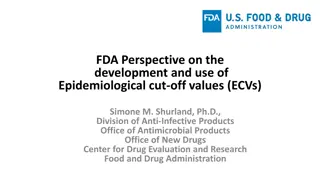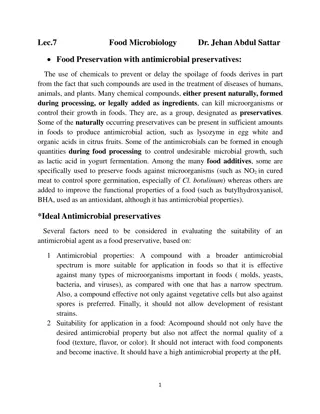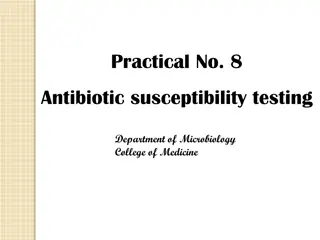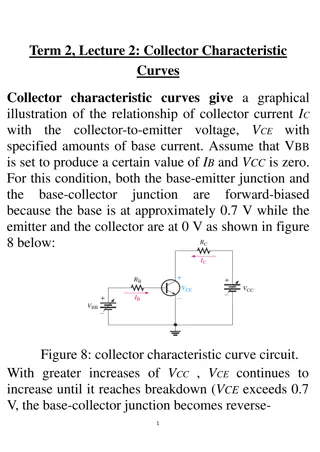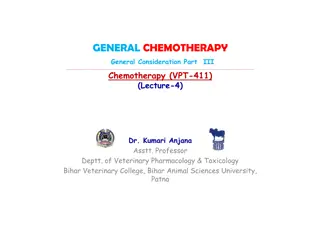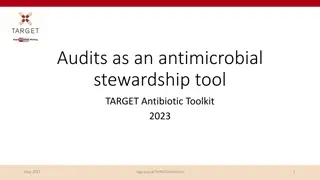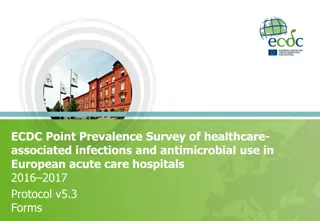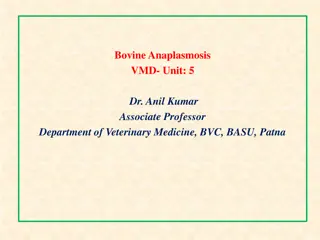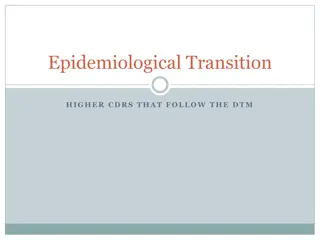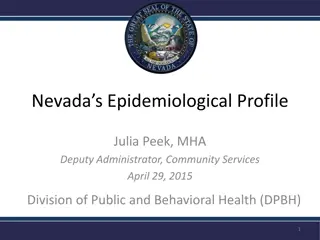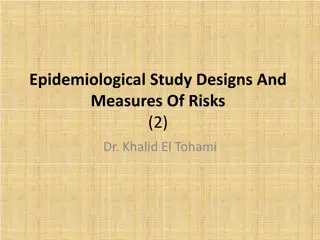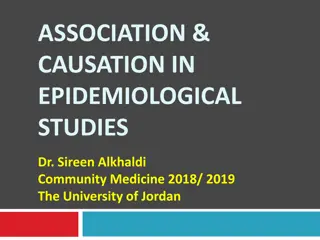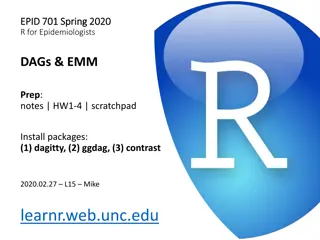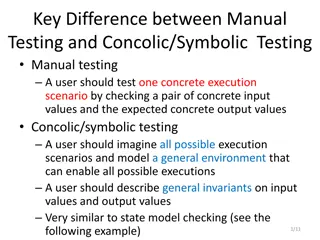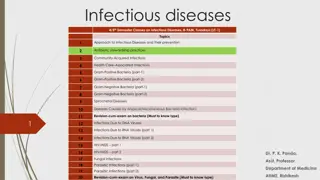Overview of Epidemiological Cutoff Values (ECVs) in Antimicrobial Susceptibility Testing
Epidemiological Cutoff Values (ECVs) are crucial in determining antimicrobial susceptibility by distinguishing wild-type and non-wild-type microbial populations. ECVs are defined based on factors like minimal inhibitory concentration (MIC) and genetic variation, and are determined through specific methodologies involving data collection and analysis. Reliable ECVs are essential for accurate interpretation of antimicrobial susceptibility results across different laboratories and geographic regions.
Download Presentation

Please find below an Image/Link to download the presentation.
The content on the website is provided AS IS for your information and personal use only. It may not be sold, licensed, or shared on other websites without obtaining consent from the author. Download presentation by click this link. If you encounter any issues during the download, it is possible that the publisher has removed the file from their server.
E N D
Presentation Transcript
AST SCs Perspective on the Development and Use of ECVs Matthew A. Wikler, MD, MBA, FIDSA Principal, Infectious Diseases Technology Development Consulting
Disclosures No Disclosures Relevant To This Presentation The AST SC s Perspective On The Development And Use Of ECVs Is Still Being Discussed And Considered What Is In Our Documents Today Issues Still Being Discussed My Personal Perspectives
Current AST Definitions epidemiological cutoff value (ECV) the minimal inhibitory concentration (MIC) or zone diameter value that separates microbial populations into those with and without acquired and/or mutational resistance based on their phenotypes (wild- type or non-wild-type). The ECV defines the upper limit of susceptibility for the wild-type population of isolates. wild-type an ECV interpretive category defined by an ECV that describes isolates with no mechanisms of acquired resistance or reduced susceptibility for the antimicrobial agent being evaluated. non-wild-type an ECV interpretive category defined by an ECV that describes isolates with presumed or known mechanisms of acquired resistance and reduced susceptibility for the antimicrobial agent being evaluated.
M23 Determination of Epidemiological Cutoff Values ECVs should be determined for each organism or group of organisms for which breakpoints are proposed. ECVs are determined by collecting and merging MIC distribution data from a range of sources and applying techniques for estimating the upper end of the wild-type distribution. To be reliable, ECVs are estimated by accounting for both biological (strain-to-strain) variation and MIC assay variation within and among laboratories. They are based on the assumption that the wild-type distribution of a particular antimicrobial agent organism combination does not vary geographically or over time. A number of conditions must be fulfilled to generate reliable ECVs. The most important are: An ECV can be determined only within a single species because of the genetic diversity among species within a genus. MIC values included in the merged dataset must have been determined using a recognized reference method such as the CLSI MIC broth dilution method (refer to CLSI document M072), which is also the international reference standard.23 Data must be sourced from at least three separate laboratories, and there should be at least 100 unique strains included in the merged dataset and weighted before pooling if more than 50% of MICs were generated in a single laboratory. As much as possible, the MIC values included in an individual laboratory s data must be on scale. This condition applies particularly to MICs of the presumptive wild-type strains. Before merging data for ECV estimation, the MIC distribution from each individual laboratory is inspected, and if the lowest concentration tested is also a mode, these data cannot be included in the merged dataset. Once acceptable data are merged, a number of methods can be used to estimate the ECV. The method used to determine ECVs should be described. The simplest method is visual inspection, which generally works for MIC distributions when there is clear separation of wild-type and non-wild-type. When there is no clear separation between wild-type and non-wild-type strains, visual inspection becomes subjective and recourse to statistical methods should be considered to remove any potential observer bias from the estimation. Several methods have been proposed and published.24-29 The sponsor should explain and justify the methodology that is used. Estimation of ECVs from MIC distributions may be supplemented with molecular tests for known resistance mechanisms as a form a confirmation. The detection of a resistance gene per se in organisms with MICs at or below the ECV does not necessarily invalidate the choice of ECV, unless it can be accompanied by evidence that the gene is being expressed.
Epidemiological Cutoff Value (ECV) Working Group Audrey Schuetz, MD, Chair April Bobenchik, PhD, Recording Secretary Paul Edelstein, MD George Eliopoulos, MD Janet Hindler, MCLS, MT (ASCP) Susan Kircher, MS, MT (ASCP) Jim Lewis, PharmD Matt Wikler, MD, MBA
ECV Working Group Charges Provide guidance to AST SC for the following: When to set an ECV versus a clinical breakpoint Interpretation and reporting for ECVs when no clinical breakpoint is available Where to publish ECVs currently in Appendix G of M100 Encourage a multidisciplinary approach to ECV setting and reporting Including antifungal and veterinary antimicrobial susceptibility testing committees and other sources as applicable
Whats Old is New Again Not Really ECVs Once Were The Breakpoints In Early Years Of My Involvement (1980s) With CLSI I Realized That This Made Little Sense SO, I BECAME THE SQUEAKY WHEEL. Jim Jorgensen Allowed The Squeaky Wheel To Become Part Of The Process ULTIMATELY LEAD TO DEVELOPMENT OF M23 DOCUMENT
Subcommittee on Antimicrobial Susceptibility Subcommittee on Antimicrobial Susceptibility Testing Mission Statement Testing Mission Statement The ultimate purpose of the subcommittee s mission is to provide useful information to enable laboratories to assist the clinician in the selection of appropriate antimicrobial therapy for patient care. The standards and guidelines are meant to be comprehensive and to include all antimicrobial agents for which the data meet established CLSI guidelines. The values that guide this mission are quality, accuracy, fairness, timeliness, teamwork, consensus, and trust.
Problems with ECVs Being The Breakpoint Does Not Account For PK/PD Or Clinical Response Correlations Just Because An Isolate Is Wild Type , Therefore Has No Known Resistance Mechanism To The Antimicrobial, Does NOT Mean That Concentrations Are Adequate Or That PD Targets Are Met May Not Be Able To Administer Adequate Doses Due To Toxicity (Colistin) Conversely, Just Because An Isolate Is Not Wild Type , And Has A Known Resistance Mechanism, Does NOT Mean That The PD Targets Are Not Met For Some Cephalosporins Animal Studies Demonstrate That PD Targets Are Met For Some Organisms With Relevant Resistance Mechanisms Therefore Need To Make Certain That Labs Do NOT Report Or Imply That ECVs Predict Clinical Response Otherwise Patients May Be Harmed
My Personal Perspective When To Set An ECV Versus A Clinical Breakpoint The Value Of ECVs Are Completely Different That Those Of Clinical Breakpoints; Therefore, May Be Of Value To Have Both ECVs Solely For Epidemiologic Purposes Clinical Breakpoints For Clinical Reporting Purposes Interpretation And Reporting For ECVs When No Clinical Breakpoint Is Available As ECVs Have Not Been Validated By PK/PD Or Clinical Data, They Should Not Be Reported To A Clinician For An Individual Patient MICs (And Possibly ECVs) Should Only Be Made Available To ID Physician Or Other Appropriately Trained Healthcare Provider When No Clinical Breakpoint Established Where To Publish ECVs Currently In Appendix G Of M100 To Avoid Confusion And Potential Misuse Of ECVs, Would Publish Only Online At CLSI Website
Summary Methods For Determining ECVs Is Similar Between EUCAST And CLSI ECVs Are Good For Epidemiologic Purposes The Role Of ECVs Relative To Patient Care Requires A Good Deal More Debate Should ECVs Be Reported When There Are No Clinical Breakpoints? If So, What Is The Best Manner In Which To Report And Utilize Such Information


